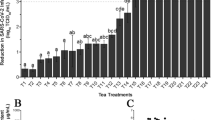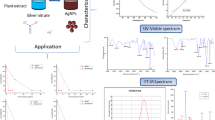Abstract
Acanthamoeba causes diseases such as Acanthamoeba keratitis (AK) which leads to permanent blindness and granulomatous Acanthamoeba encephalitis (GAE) where there is formation of granulomas in the brain. Current treatments such as chlorhexidine, diamidines, and azoles either exhibit undesirable side effects or require immediate and prolonged treatment for the drug to be effective or prevent relapse. Previously, antifungal drugs amphotericin B, nystatin, and fluconazole-conjugated silver with nanoparticles have shown significantly increased activity against Acanthamoeba castellanii. In this study, two functionally diverse tetrazoles were synthesized, namely 5-(3-4-dimethoxyphenyl)-1H-tetrazole and 1-(3-methoxyphenyl)-5-phenoxy-1H-tetrazole, denoted by T1 and T2 respectively. These compounds were evaluated for anti-Acanthamoeba effects at different concentrations ranging from 5 to 50 μM. Furthermore, these compounds were conjugated with silver nanoparticles (AgNPs) to enhance their efficacy. Particle size analysis showed that T1-AgNPs and T2-AgNPs had an average size of 52 and 70 nm respectively. After the successful synthesis and characterization of tetrazoles and tetrazole-conjugated AgNPs, they were subjected to anti-Acanthamoeba studies. Amoebicidal assay showed that at concentration 10 μM and above, T2 showed promising antiamoebic activities between the two compounds while encystation and excystation assays reveal that both T1 and T2 have inhibited differentiation activity against Acanthamoeba castellanii. Conjugation of T1 and T2 to AgNP also increased efficacy of tetrazoles as anti-Acanthamoeba agents. This may be due to the increased bioavailability as AgNP allows better delivery of treatment compounds to A. castellanii. Human cell cytotoxicity assay revealed that tetrazoles and AgNPs are significantly less toxic towards human cells compared with chlorhexidine which is known to cause undesirable side effects. Cytopathogenicity assay also revealed that T2 conjugated with AgNPs significantly reduced cytopathogenicity of A. castellanii compared with T2 alone, suggesting that T2-conjugated AgNP is an effective and safe anti-Acanthamoeba agent. The use of a synthetic azole compound conjugated with AgNPs can be an alternative strategy for drug development against A. castellanii. However, mechanistic and in vivo studies are needed to explore further translational values.








Similar content being viewed by others
Change history
24 January 2022
This article has been retracted. Please see the Retraction Notice for more detail: https://doi.org/10.1007/s00436-022-07440-8
References
Anwar A, Siddiqui R, Hussain MA, Ahmed D, Shah MR, Khan NA (2018) Silver nanoparticle conjugation affects antiacanthamoebic activities of amphotericin B, nystatin, and fluconazole. Parasitol Res 117(1):265–271
Anwar A, Khan NA, Siddiqui R (2019) Galactose as novel target against Acanthamoeba cysts. PLoS Negl Trop Dis 13(7):e0007385
Anwar A, Ting ELS, Anwar A, Ul Ain N, Faizi S, Shah MR, Khan NA, Siddiqui R (2020) Antiamoebic activity of plant-based natural products and their conjugated silver nanoparticles against Acanthamoeba castellanii (ATCC 50492). AMB Express 10(1):24
Aqeel Y, Siddiqui R, Anwar A, Shah MR, Khoja S, Khan NA (2015) Photochemotherapeutic strategy against Acanthamoeba infections. Antimicrob Agents Chemother 59(6):3031–3041
Aqeel Y, Siddiqui R, Anwar A, Shah MR, Khan NA (2016) Gold nanoparticle conjugation enhances the antiacanthamoebic effects of chlorhexidine. Antimicrob Agents Chemother 60(3):1283–1288
Band RN, Mohrlok S (1973) The cell cycle and induced amitosis in Acanthamoeba. J Protozool 20(5):654–657
Barisani-Asenbauer T, Walochnik J, Mejdoubi L, Binder S (2012) Successful management of recurrent Acanthamoeba keratitis using topical and systemic miltefosine. Acta Ophthalmol 90:0–0
Bello-Vieda N, Pastrana H, Garavito M, Ávila A, Celis A, Muñoz-Castro A, Restrepo S, Hurtado J (2018) Antibacterial activities of azole complexes combined with silver nanoparticles. Molecules 23(2):361
Bendensky A, Menéndez D, Ostrosky-Wegman P (2002) Is metronidazole carcinogenic? Mutat Res/Rev Mutat Res 511(2):133–144
Cabello-Vílchez AM, Martín-Navarro CM, López-Arencibia A, Reyes-Batlle M, Sifaoui I, Valladares B, Piñero JE, Lorenzo-Morales J (2014) Voriconazole as a first-line treatment against potentially pathogenic Acanthamoeba strains from Peru. Parasitol Res 113(2):755–759
Cano PA, Islas-Jácome A, González-Marrero J, Yépez-Mulia L, Calzada F, Gámez-Montaño R (2014) Synthesis of 3-tetrazolylmethyl-4H-chromen-4-ones via Ugi-azide and biological evaluation against Entamoeba histolytica, Giardia lamblia and Trichomona vaginalis. Bioorg Med Chem 22(4):1370–1376
Chopra A, Khuller GK (1983) Lipids of pathogenic fungi. Prog Lipid Res 22(3):189–220
Dai LL, Zhang HZ, Nagarajan S, Rasheed S, Zhou CH (2015) Synthesis of tetrazole compounds as a novel type of potential antimicrobial agents and their synergistic effects with clinical drugs and interactions with calf thymus DNA. MedChemComm 6(1):147–154
Dart JK, Saw VP, Kilvington S (2009) Acanthamoeba keratitis: diagnosis and treatment update 2009. Am J Ophthalmol 148(4):487–499
Egger S, Lehmann RP, Height MJ, Loessner MJ, Schuppler M (2009) Antimicrobial properties of a novel silver-silica nanocomposite material. Appl Environ Microbiol 75(9):2973–2976
Fatima I, Zafar H, Khan KM, Saad SM, Javaid S, Perveen S, Choudhary MI (2018) Synthesis, molecular docking and xanthine oxidase inhibitory activity of 5-aryl-1H-tetrazoles. Bioorg Chem 79:201–211
Garajová M, Mrva M, Timko L, Lukáč M, Ondriska F (2014) Cytomorphological changes and susceptibility of clinical isolates of Acanthamoeba spp. to heterocyclic alkylphosphocholines. Exp Parasitol 145:S102–S110
Garajová M, Mrva M, Vaškovicová N, Martinka M, Melicherová J, Valigurová A (2019) Cellulose fibrils formation and organisation of cytoskeleton during encystment are essential for Acanthamoeba cyst wall architecture. Sci Rep 9(1):4466
Gupta AK, Lyons DC (2015) The rise and fall of oral ketoconazole. J Cutan Med Surg 19(4):352–357
Hitchcock CA, Dickinson K, Brown SB, Evans EGV, Adams DJ (1990) Interaction of azole antifungal antibiotics with cytochrome P-450-dependent 14α-sterol demethylase purified from Candida albicans. Biochem J 266(2):475–480
Khan NA (2006) Acanthamoeba: biology and increasing importance in human health. FEMS Microbiol Rev 30(4):564–595
Khunkitti W, Lloyd DFJR, Furr JR, Russell AD (1998) Acanthamoeba castellanii: growth, encystment, excystment and biocide susceptibility. J Inf Secur 36(1):43–48
Kim S, Kwon K, Kwon IC, Park K (2009) Nanotechnology in drug delivery: past, present, and future. In: Nanotechnology in drug delivery. Springer, New York, pp 581–596
Köhsler M, Mrva M, Walochnik J (2016) Acanthamoeba. In: Molecular parasitology. Protozoan parasites and their molecules. Springer-Verlag, Wien, pp 285–324
Kulsoom H, Baig AM, Siddiqui R, Khan NA (2014) Combined drug therapy in the management of granulomatous amoebic encephalitis due to Acanthamoeba spp., and Balamuthia mandrillaris. Exp Parasitol 145:S115–S120
Lamb DC, Warrilow AG, Rolley NJ, Parker JE, Nes WD, Smith SN, Kelly DE, Kelly SL (2015) Azole antifungal agents to treat the human pathogens Acanthamoeba castellanii and Acanthamoeba polyphaga through inhibition of sterol 14α-demethylase (CYP51). Antimicrob Agents Chemother 59(8):4707–4713
Lingling D, Shengfeng C, Damu GL, Chenghe Z (2013) Recent advances in the synthesis and application of tetrazoles. Chinese J Org Chem 33(2):224–244
Lorenzo-Morales J, Khan NA, Walochnik J (2015) An update on Acanthamoeba keratitis: diagnosis, pathogenesis and treatment. Parasite 22:10
Łukowska-Chojnacka E, Mierzejewska J, Milner-Krawczyk M, Bondaryk M, Staniszewska M (2016) Synthesis of novel tetrazole derivatives and evaluation of their antifungal activity. Bioorg Med Chem 24(22):6058–6065
Nampoothiri RV, Malhotra P, Jain A, Batra N, Gupta K, Saj F, Khurana S, Mahalingam H, Lal A, Mukherjee K, Radotra B, Varma S (2018) An unusual cause of central nervous system infection during acute myeloid leukemia induction chemotherapy: Acanthamoeba brain abscess. Indian J Hematol Blood Transfus 34(1):153–155
Padzik M, Hendiger EB, Chomicz L, Grodzik M, Szmidt M, Grobelny J, Lorenzo-Morales J (2018) Tannic acid-modified silver nanoparticles as a novel therapeutic agent against Acanthamoeba. Parasitol Res 117(11):3519–3525
Padzik M, Hendiger EB, Żochowska A, Szczepaniak J, Baltaza W, Pietruczuk-Padzik A, Olędzka G, Chomicz L (2019) Evaluation of in vitro effect of selected contact lens solutions conjugated with nanoparticles in terms of preventive approach to public health risk generated by Acanthamoeba strains. Ann Agric Environ Med 26(1):198–202
Parveen S, Misra R, Sahoo SK (2012) Nanoparticles: a boon to drug delivery, therapeutics, diagnostics and imaging. Nanomed: Nanotechnol Biol Med 8(2):147–166
Schuster FL, Visvesvara GS (2004) Free-living amoebae as opportunistic and non-opportunistic pathogens of humans and animals. Int J Parasitol 34(9):1001–1027
Sharma R, Jhanji V, Satpathy G, Sharma N, Khokhar S, Agarwal T (2013) Coinfection with Acanthamoeba and Pseudomonas in contact lens–associated keratitis. Optom Vis Sci 90(2):e53–e55
Siddiqui R, Khan NA (2012) Biology and pathogenesis of Acanthamoeba. Parasit Vectors 5(1):6
Sissons J, Alsam S, Stins M, Rivas AO, Morales JL, Faull J, Khan NA (2006) Use of in vitro assays to determine effects of human serum on biological characteristics of Acanthamoeba castellanii. J Clin Microbiol 44(7):2595–2600
Slater CA, Sickel JZ, Visvesvara GS, Pabico RC, Gaspari AA (1994) Successful treatment of disseminated Acanthamoeba infection in an immunocompromised patient. N Engl J Med 331(2):85–87
Tavassoli S, Buckle M, Tole D, Chiodini P, Darcy K (2018) The use of miltefosine in the management of refractory Acanthamoeba keratitis. Contact Lens Anterior Eye 41(4):400–402
Timko L, Fischer-Fodor E, Garajová M, Mrva M, Chereches G, Ondriska F, Bukovský M, Lukáč M, Karlovská J, Kubincová J, Devínsky F (2015) Synthesis of structural analogues of hexadecylphosphocholine and their antineoplastic, antimicrobial and amoebicidal activity. Eur J Med Chem 93:263–273
Tu EY, Joslin CE, Shoff ME (2010) Successful treatment of chronic stromal Acanthamoeba keratitis with oral voriconazole monotherapy. Cornea 29(9):1066
Webster D, Umar I, Kolyvas G, Bilbao J, Guiot MC, Duplisea K, Qvarnstrom Y, Visvesvara GS (2012) Treatment of granulomatous amoebic encephalitis with voriconazole and miltefosine in an immunocompetent soldier. Am J Trop Medi Hyg 87(4):715–718
Weisman RA (1976) Differentiation in Acanthamoeba castellanii. Annu Rev Microbiol 30(1):189–219
Xuguang S, Lin C, Yan Z, Zhiqun W, Ran L, Shiyun L, Xiuying J (2003) Acanthamoeba keratitis as a complication of orthokeratology. Am J Ophthalmol 136(6):1159–1161
Zazo H, Colino CI, Lanao JM (2016) Current applications of nanoparticles in infectious diseases. J Control Release 224:86–102
Funding
This work is supported by the Sunway University, Malaysia (GRTIN-RRO-98-2020), and the Pakistan Academy of Sciences for providing financial support Project No. (5-9/PAS/440).
Author information
Authors and Affiliations
Contributions
The study was conducted by team effort of all authors. The manuscript was submitted with the consent of all authors.
Corresponding author
Ethics declarations
Conflict of interest
The authors declare that they have no conflict of interest.
Ethical approval
Not required.
Additional information
Section Editor: Julia Walochnik
Publisher’s note
Springer Nature remains neutral with regard to jurisdictional claims in published maps and institutional affiliations.
This article has been retracted. Please see the retraction notice for more detail: https://doi.org/10.1007/s00436-022-07440-8
About this article
Cite this article
Anwar, A., Yi, Y.P., Fatima, I. et al. RETRACTED ARTICLE: Antiamoebic activity of synthetic tetrazoles against Acanthamoeba castellanii belonging to T4 genotype and effects of conjugation with silver nanoparticles. Parasitol Res 119, 1943–1954 (2020). https://doi.org/10.1007/s00436-020-06694-4
Received:
Accepted:
Published:
Issue Date:
DOI: https://doi.org/10.1007/s00436-020-06694-4




